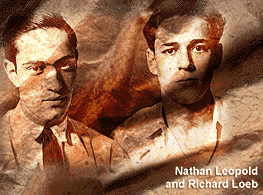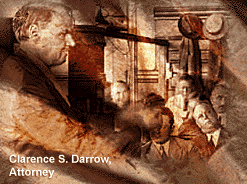FILM NOTES

 Compulsion
Compulsion
(American, 1959, 103 minutes, b&w, 16mm)
Directed by Richard Fleischer
Cast:
Orson Welles . . . . . . . . . . Jonathan Wilk
Dean Stockwell . . . . . . . . . . Judd Steiner
Martin Milner . . . . . . . . . . Sid Brooks
Bradford Dillman . . . . . . . . . . Artie Straus
Diane Varsi . . . . . . . . . . Ruth Evans
E. G. Marshall . . . . . . . . . . District Attorney Harold Hor
The
following film notes were prepared for the New York State Writers
Institute by Kevin Jack Hagopian, Senior Lecturer in Media Studies
at Pennsylvania State University:
For three generations of Chicago children and their parents, it has been a real-life Halloween story, a tragic, horrifying nightmare. It happened on a summer day in 1924. A fourteen-year-old boy, Bobby Franks, was on his way home from school. A handsome, well-dressed young man who had long been a friend of his family called to him, and he joined the man and his companion for a ride home in their car. Bobby sat in the front seat. From the back seat, without warning, he was struck a huge blow by a chisel. Unconscious, he slumped over and bled to death. The young men drove the corpse to a deserted industrial area, and tossed it into a weedy culvert. Then, they delivered a ransom note to the boy's wealthy parents. They sat back, nervously, and waited.
The young men were Nathan Leopold and Richard Loeb. Eighteen-year-old Loeb was outgoing and an athlete, known for being kind and thoughtful. Nineteen-year-old Leopold, the introvert, was a certified genius. He spoke several languages, and was an accomplished botanist, as well as an exceptional student at the University of Chicago. Both were intellectually precocious, years ahead of their age peers. Yet their crime was essentially a juvenile prank, dressed up with adult means. They had killed the boy simply to see if they could get away with it; they hadn’t even been particularly looking for Bobby Franks. They believed they could outwit the police, but the body was quickly found, and with it, a pair of Leopold’s eyeglasses. In a matter of days, their dream of a ‘perfect crime’ was gone, and the two were indicted for first-degree murder and kidnapping. Each crime was punishable by death. In the public imagination, Leopold and Loeb became rich, cruel, and outrageous, Leob the mad genius, Leopold the adoring dupe. Although it was expressed in the code words of the time, imputations of homosexuality further roiled an angry citizenry. An incendiary bloodlust, fueled by Chicago’s lurid crime journalists, swept a city that had thought itself inured to violent killings. But this was not a fraternal killing of a bootlegger. This was the coldblooded murder of a boy by two spoiled rich kids, and it seemed the whole city, rich and poor, wanted them dead. When legendary attorney Clarence Darrow was called in by the families of Leopold and Loeb, he would say later without exaggeration, "the two boys were in the shadow of the gallows."
Darrow pled them guilty, and asked that they be tried before a judge. Darrow didn’t believe there were twelve citizens in all of Chicago who would even consider the possibility of mercy. He didn’t cross-examine a single one of the State’s witnesses who recounted the ghastly details of the crime. Instead, he staked his clients’ lives on a monumental, poetic summation that lasted two full days and when printed ran to sixty thousand words. The core of his argument was the barbarity of the death penalty, the manner in which the boys’ strange authoritarian fantasies had warped their souls, and the faint hope that the defendants, one or the other, might someday lead lives of worth and value to society—if those lives were not snuffed out by a vengeful state. If Bobby Franks’ mother, now bereaved, was to be pitied, said Darrow, were not the mothers of Leopold and Loeb also deserving of compassion? Might not either of these two boys someday also have been a good and useful citizen as a cold and callous one, if given hope and care?
 His arguments were daring, his tone passionate, and he seemed to gaze directly into the dark, raging heart of the city. Darrow, the great cynic and professional agnostic, appealed to the godliness of mercy in all men and women, not just in the beleaguered Judge John Caverly. Darrow preached a gospel of mitigation and grace powerful enough to sway press and people, not just the bench. This worst, most vile of all murder cases turned out to be the first great landmark in the struggle against the death penalty, and Darrow’s words, "I do not care about that book above, if I be written in the Book of Love," still resound. In the end, Darrow’s heroic oration, the most physically exhausting hours of his life, saved his pathetic clients’ lives. Their families, he said, never paid him.
His arguments were daring, his tone passionate, and he seemed to gaze directly into the dark, raging heart of the city. Darrow, the great cynic and professional agnostic, appealed to the godliness of mercy in all men and women, not just in the beleaguered Judge John Caverly. Darrow preached a gospel of mitigation and grace powerful enough to sway press and people, not just the bench. This worst, most vile of all murder cases turned out to be the first great landmark in the struggle against the death penalty, and Darrow’s words, "I do not care about that book above, if I be written in the Book of Love," still resound. In the end, Darrow’s heroic oration, the most physically exhausting hours of his life, saved his pathetic clients’ lives. Their families, he said, never paid him.
For their part, the two murderers seemed determined to prove Darrow’s thesis about the duality of human nature eerily correct. Loeb grew tough and angry in Illinois’ Stateville prison, and was killed in a knife fight there in 1936. Leopold, on the other hand, was a model prisoner, courageously volunteering for a dangerous malaria vaccination experiment during World War II, and later setting up a successful correspondence school for prisoners. He wrote a clear-eyed but remorseful autobiography, Life Plus 99 Years, while still in prison. So exemplary was his conduct that, with Erle Stanley Gardner and Carl Sandburg testifying at his parole hearing, he won release in 1958.
One of the reporters watching the case unfold in 1924 and seeing Darrow’s spellbinding plea was young Meyer Levin, writing for his college newspaper. Levin had gone on to a career as a well-regarded novelist, authoring, among others, The Old Bunch, a brilliant novel of middle-class and upper-middle-class Chicago Jewish teenagers in the 1920s, the milieu of Loeb and Leopold. He knew that the case had been lingering like a running canker in the nation’s psyche. In 1956, he wrote Compulsion, a novel very closely based on the events of thirty years before. Compulsion became a best-seller, and Levin adapted it into a play, also successful. Studios swarmed after the property. Alfred Hitchcock’s 1948 film ROPE had also been based on the case, but much more loosely. COMPULSION’s advertising stressed the film’s faithful recreation of the events of that hot summer in 1924.
 Yet, for all its careful period detail, COMPULSION is a Fifties film. Fifties’ fixations about effeminacy and latent homosexuality color the portrayals of the two killers with the decade’s own paranoias. To complement these outsized performances, Richard Fleischer’s direction is subtle and meticulous. His forte was wordless, tense scenes during moody crime dramas. A stairway assassination in his great B film noir, THE NARROW MARGIN (1952), the slow split-screen progress of Albert DeSalvo in THE BOSTON STRANGLER (1968), and the creepy, prosaic serial killings of TEN BILLINGTON PLACE (1971); each is more stately and frightening without dialogue. COMPULSION’s first half, in particular, seems to portion its anxieties out drop by agonizing drop. Orson Welles’ portrayal of the Darrow surrogate Jonathan Wilk borrows the spirit (and some of the very phrases) of Darrow’s epic closing, and strains it through Welles’ own towering style. His final speech to the judge, at fifteen minutes in length, is one of the longest by a single character in the American cinema. Welles wisely underplays Wilk, making him world-weary and inward-turning, banking the fires Darrow himself had let roar up. Wilk is the calm center of a film that seethes with the unspoken fears of a postwar era that had already known mad bombers, lipstick killers, spree murderers, and silent stranglers, each wearing the winning smile of the boy next door. Like Elia Kazan’s SPLENDOR IN THE GRASS, COMPULSION combines the portrait of a family splintering under pressure with a violent sexual undercurrent. The result is one of the most deftly realized and suspenseful films of the 1950s.
Yet, for all its careful period detail, COMPULSION is a Fifties film. Fifties’ fixations about effeminacy and latent homosexuality color the portrayals of the two killers with the decade’s own paranoias. To complement these outsized performances, Richard Fleischer’s direction is subtle and meticulous. His forte was wordless, tense scenes during moody crime dramas. A stairway assassination in his great B film noir, THE NARROW MARGIN (1952), the slow split-screen progress of Albert DeSalvo in THE BOSTON STRANGLER (1968), and the creepy, prosaic serial killings of TEN BILLINGTON PLACE (1971); each is more stately and frightening without dialogue. COMPULSION’s first half, in particular, seems to portion its anxieties out drop by agonizing drop. Orson Welles’ portrayal of the Darrow surrogate Jonathan Wilk borrows the spirit (and some of the very phrases) of Darrow’s epic closing, and strains it through Welles’ own towering style. His final speech to the judge, at fifteen minutes in length, is one of the longest by a single character in the American cinema. Welles wisely underplays Wilk, making him world-weary and inward-turning, banking the fires Darrow himself had let roar up. Wilk is the calm center of a film that seethes with the unspoken fears of a postwar era that had already known mad bombers, lipstick killers, spree murderers, and silent stranglers, each wearing the winning smile of the boy next door. Like Elia Kazan’s SPLENDOR IN THE GRASS, COMPULSION combines the portrait of a family splintering under pressure with a violent sexual undercurrent. The result is one of the most deftly realized and suspenseful films of the 1950s.
Nathan Leopold read and watched COMPULSION with bitterness. Compulsion portrayed him as a sexual deviate, he said; he was embarrassed to read some of the acts attributed to his literary self, "Judd Steiner." Leopold sued Levin and Richard D. Zanuck, the film’s producer, for violating his privacy. The case was not decided until 1970, when a court ruled that the case constituted a kind of American legend, and that Leopold was therefore a public figure, not entitled to a presumption of privacy. Leopold died quietly a year later, a sedate, well-groomed old man who had once been the sadistic co-author of the "crime of the century."
Compulsion was in fact Leopold’s best friend. The book and film may well have swayed parole board members in his favor. Levin had testified, unasked, at Leopold’s hearing. By opening up the inscrutable mind of the psychotic criminal, even in a fictionalized way, Compulsion gave a human face to the most inhuman of crimes. Hearing Darrow’s words once again, now on the page and on the screen, Leopold once again found mercy from a public that didn’t know it could weep for a killer as much as for his victim.
— Kevin Hagopian, Penn State University
For additional information, contact the Writers Institute at 518-442-5620 or online at https://www.albany.edu/writers-inst.